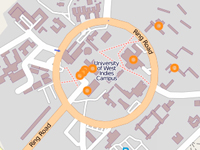Licensing and Purchasing Considerations
Licensing and Purchasing Considerations & FOSS
This is an extract from a document produced for Mona’s ICT Steering Committee ‘Review and make an assessment of the relevance and utilization of the current Campus software inventory’
Our enterprise applications (PeopleSoft, Banner Finance/Student and TMA) and their support platforms are not included in this discussion. The focus is on academic software, desktop and ICT proficiency tools.
Overview
MITS has consistently tried to ensure that the software purchased and paid for by MITS, for the Campus’ academic programme and for desktop productivity support, are relevant to the stated intent of the user departments, support the larger strategic goals of the Campus, and that the acquisition allows the Campus to optimize its purchasing outcome. How is this done? The head of department is asked to attest to the need for the purchase of the particular item requested, by asserting that the item is required for the teaching programme or the research undertaking. This is done by way of completing and signing the Software Request Form. MITS is of the view that the academic users are better able to determine the software needed for their teaching and research programmes, than MITS can.
There are also stated guidelines for determining what items of software may be purchased from the MITS budget (i.e. the Central IT budget). These guidelines are outlined below:
In general, we try to avoid purchasing, from the MITS budget, multiple items with similar core functionalities, but this is not always avoidable. We also try to determine what software the better known universities are using, in order to broaden our appreciation of the academic software needs.
Licensing conditions are carefully examined to determine the best fit for the particular need at the best cost. For instance, if there are 100 students to be served in a particular programme, using a lab of 25 computers then the appropriate licensing is likely to be 25 concurrent, instead of 100 or campus-wide.
License distribution is managed by MITS through the Software Administrator. Distribution (cf. installation) is done using authorized IT personnel from MITS or using the Lab Managers. Each distribution is accompanied by a document, signed by the technical person responsible, attesting to the installations of the licenses.
From time to time MITS re-assesses utilization to determine whether to modify the licensing regime for the particular product being reviewed.
Where departments, not under the UGC umbrella, require usage of the software purchased from the MITS budget, there is a requirement to pay for the licenses at cost plus a small fee for handling (up to 10%).
The approach we take to provisioning and administering software goes a long way in ensuring that the software budget is used to support the core business of the Mona Campus optimally and practically.
Concerning licensing and cost:
As far as possible MITS tries to consolidate the item list (i.e. items purchased through MITS funding) in order to limit purchase of items which are merely alternatives to existing ones, requested simply out of preference.
There is commitment to investigating free and open source software where a ‘mature’ alternative exists. (Note: There are prescribed rules for assessing software maturity). Drupal, our open source content management system, has replaced the original web tool (Dreamweaver) we once used.
Across the industry there are three or four different licensing strategies available to us but our basic approach is always underpinned by cost effectiveness. For instance, where it is expedient to purchase a site license over a volume license, that is what is done (see below). MITS pursues the ‘academic option’ wherever possible.
Many of the software items that are purchased, are under broad based licensing e.g. Campus-wide or University-wide. Others are volume purchases or a site purchase for a particular department. In a few cases, MITS purchases a handful of licenses for evaluation or for a critical academic need. Software is also purchased for technology development or for technology administration and support. These are usually specific to MITS. A comprehensive list of the software in-house is available here.
The types of licenses used include:
- Campus wide license (or University wide) - which is usually applied to products used across the board (i.e. widespread demand)
- Site license - which is usually for products which apply to a particular subject area/department. A variant of this is the network license which allows service over the network.
- Volume license (sometimes discounted by numbers) - This allows the flexibility of supplying multiple groups without having to purchase a Campus wide license.
- Concurrent usage vs. single installation - the former allowing us to re-use the licenses for various groups up to a given number operating together at a time. Some of our lab installed items are so licensed. On the other hand the single-installation might be an item installed on the lecturer’s computer or on a few lab computers as ‘stand-alone’.


 Facebook
Facebook YouTube
YouTube Twitter
Twitter WhatsApp +1(876) 499-2291
WhatsApp +1(876) 499-2291